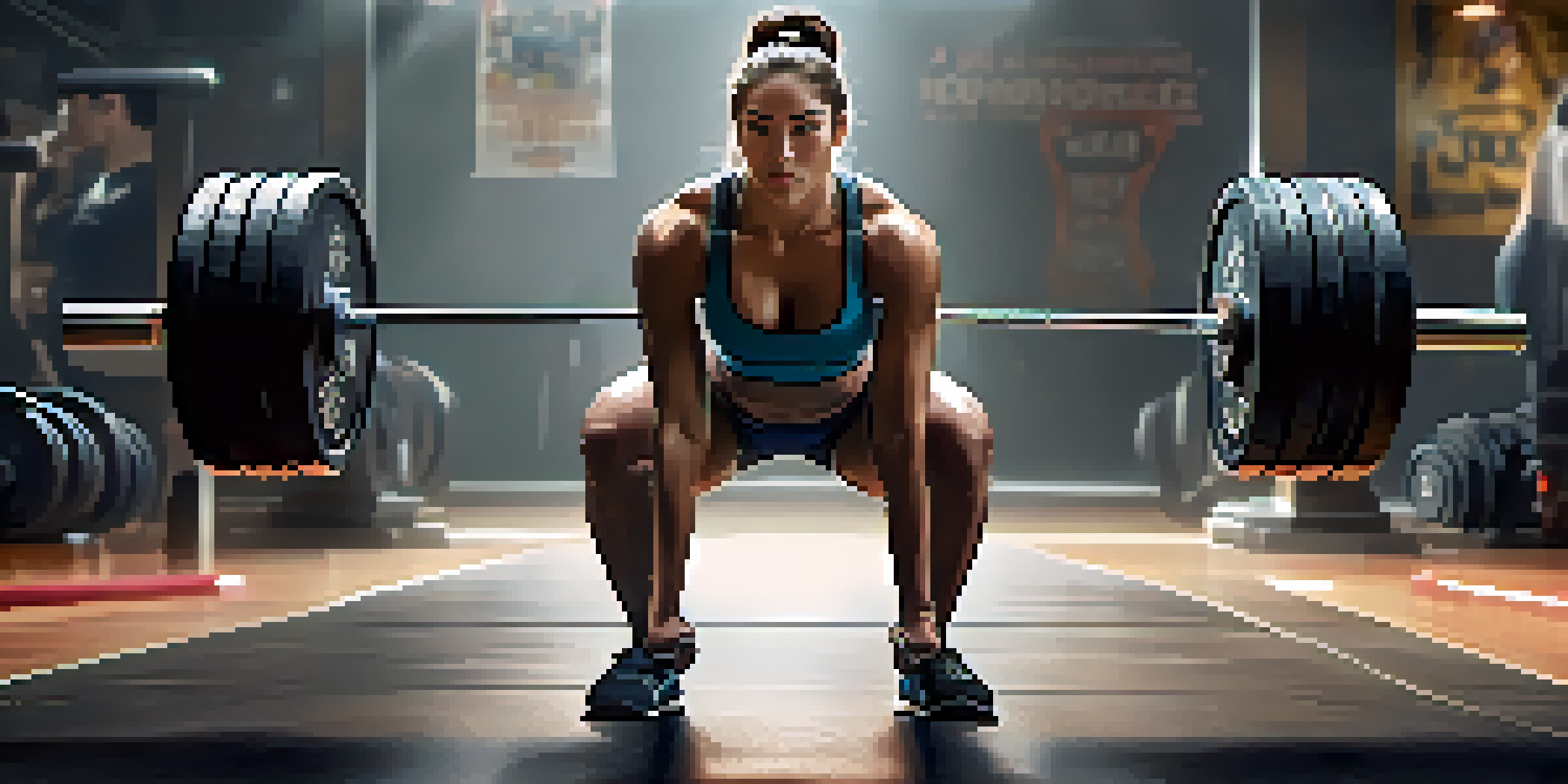Injury Prevention in Powerlifting and CrossFit Techniques

Understanding Common Injuries in Powerlifting and CrossFit
In both powerlifting and CrossFit, athletes often face similar injury risks. Common injuries include strains, sprains, and joint issues, typically arising from improper techniques or inadequate warm-ups. For instance, many athletes may overlook the importance of engaging their core, which is crucial for maintaining stability during heavy lifts.
The key to injury prevention is not just to avoid pain, but to understand your body and its signals.
Understanding these injuries can help you take proactive measures. For example, knee injuries can often stem from poor squat mechanics, while shoulder injuries may arise from incorrect overhead lifting techniques. Recognizing these patterns allows lifters to adjust their training accordingly, reducing the risk of injury.
Ultimately, being aware of these common injuries is the first step toward prevention. By identifying the risks associated with specific movements, athletes can tailor their training to prioritize safety in both powerlifting and CrossFit.
The Importance of Proper Warm-Up Routines
A proper warm-up is like the foundation of a house—it sets the stage for everything that follows. In powerlifting and CrossFit, warming up helps prepare your muscles and joints for the demands of the workout. This might include dynamic stretches and mobility exercises to increase blood flow and flexibility.

For instance, performing shoulder dislocates with a resistance band can significantly improve your range of motion before heavy lifting. Similarly, incorporating movements like leg swings can activate your hip flexors, which are crucial for squats and other lower body exercises. This warm-up phase not only enhances performance but also plays a vital role in injury prevention.
Injury Awareness Is Key
Understanding common injuries in powerlifting and CrossFit helps athletes take proactive measures to avoid them.
By investing time in a thorough warm-up, you're ensuring that your body is ready for action. This small yet impactful step can lead to more successful training sessions and a reduced likelihood of injury.
Mastering Technique for Injury Prevention
Technique is the backbone of safe lifting practices in both powerlifting and CrossFit. Whether you’re performing a deadlift or a clean and jerk, prioritizing proper form can prevent injuries. For instance, ensuring your back remains straight during a deadlift can help avoid debilitating lower back strains.
Good technique is the foundation of all successful training; it not only maximizes performance but also minimizes injury risk.
Additionally, it’s helpful to seek feedback from coaches or experienced lifters. They can provide valuable insights on your form, identifying any flaws you may not notice. Think of this as having a second pair of eyes to catch mistakes before they lead to injury.
By consistently focusing on your technique, you’re setting yourself up for long-term success. It’s not just about lifting heavier weights; it’s about lifting smartly and safely.
Incorporating Rest and Recovery into Your Training
In the fast-paced worlds of powerlifting and CrossFit, it’s easy to overlook the necessity of rest. However, recovery is just as vital as the workouts themselves. Overtraining can lead to fatigue and injuries, making it essential to include rest days in your weekly routine.
For example, consider scheduling active recovery days where you engage in lighter activities like yoga or swimming. These activities promote blood flow without putting excessive strain on your muscles. Additionally, prioritizing sleep can enhance recovery, allowing your body to repair and strengthen.
Warm-Ups Boost Performance
A proper warm-up routine prepares your muscles and joints, enhancing performance and reducing injury risk.
By recognizing the importance of recovery, you're investing in your long-term performance. Remember, a well-rested athlete is often a stronger and more resilient one.
Utilizing Proper Equipment for Safety
The right equipment can significantly enhance safety in powerlifting and CrossFit. Investing in quality footwear, for example, can provide the necessary support and stability during lifts. A good pair of lifting shoes with a solid base can drastically improve your balance and performance.
Additionally, consider using supportive gear like knee sleeves or belts. These items not only offer extra support but can also act as reminders to maintain proper technique. Think of them as your safety net, catching you before any potential falls.
Overall, using the right equipment is a crucial element of injury prevention. It’s not just about lifting weights; it’s about lifting wisely and safely.
Listening to Your Body: Signs and Signals
Being in tune with your body is a fundamental aspect of injury prevention. Athletes often push through discomfort, but understanding the difference between pain and soreness is crucial. If you experience sharp pain during a lift, it might be time to reassess your technique or take a break.
For example, if your shoulder feels off after a workout, don’t ignore it. Taking the time to rest or seek professional advice can prevent a minor issue from becoming a serious injury. Listening to your body is like having an internal coach guiding you toward safer practices.
Listen to Your Body's Signals
Being in tune with your body helps differentiate between pain and soreness, guiding you toward safer training practices.
Ultimately, being aware of your body’s signals can empower you to make informed decisions about your training. It’s all about finding the balance between pushing your limits and respecting your body’s needs.
The Role of Cross-Training in Injury Prevention
Cross-training can be a game changer when it comes to preventing injuries in powerlifting and CrossFit. Engaging in different types of workouts allows muscles to recover while still staying active. For instance, incorporating swimming or cycling can provide a low-impact alternative that keeps your cardiovascular fitness intact.
Moreover, cross-training can help strengthen underutilized muscle groups. For example, practicing yoga can enhance your flexibility and balance, which are essential for executing complex lifts safely. This diversification not only keeps your workouts fresh but also promotes overall body strength and resilience.

By embracing cross-training, you're giving your body the chance to recover while still working towards your fitness goals. It’s a smart strategy that keeps you engaged and injury-free.